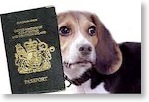Pet Passports

Before You Read/Watch
1. Imagine you have a cat. You are going on holiday for a week to another country. What do you do?
a) hide your cat in your hand luggage
b) ask a friend or neighbour to feed your cat.
c) lock the cat out of your house. She can look after herself for a week!
d) leave her in a cattery.
2. You are going to live in another country. What do you do with your dog?
a) take your dog with you
b) leave him with a friend
c) leave him in a kennel
d) take him to the woods - and forget to bring him home!
Reading
Until a few years
ago all animals entering the UK had to spend
six months in quarantine. Quarantine means
isolation from people and other animals.
The quarantine rule protected the UK against rabies or 'mad dog disease'. Rabies comes from fox or dog bites.
Quarantine was very difficult for pet owners. They didn't want to be away from their pets for six months.
The pet passport scheme maintains the UK's protection against rabies. But it makes life a lot easier for animals and their owners.
The quarantine rule protected the UK against rabies or 'mad dog disease'. Rabies comes from fox or dog bites.
Quarantine was very difficult for pet owners. They didn't want to be away from their pets for six months.
The pet passport scheme maintains the UK's protection against rabies. But it makes life a lot easier for animals and their owners.
Now
watch the slideshow
Video/Slideshow
Watch this
short presentation and answer the questions
below:
1. Are the following statements true or false?
a) It's now more difficult to take pets on flights
b) Only animals from some countries can have a pet passport.
c) Even with a pet passport animals still need to spend six months in quarantine.
d) All pets need to be vaccinated against rabies.
e) Vets provide the papers needed for the pet passport.
f) Getting a pet passport takes less than a week.
Listen again for any answers you're not sure about. Then look at the answers section on this page.
1. Are the following statements true or false?
a) It's now more difficult to take pets on flights
b) Only animals from some countries can have a pet passport.
c) Even with a pet passport animals still need to spend six months in quarantine.
d) All pets need to be vaccinated against rabies.
e) Vets provide the papers needed for the pet passport.
f) Getting a pet passport takes less than a week.
Listen again for any answers you're not sure about. Then look at the answers section on this page.
Listening (audio only)
Activities
Writing
1. A friend wants to take their pet to the UK. Write a set of instructions about how to do this.
Role Play/Game
1. This is a version of the popular game, alibi.
a) A couple bring their pet to airport customs. The animal does not look like his passport photo and the customs officer(s) ask questions to try and confirm the identity of the animal.
b) The couple go outside the classroom to prepare a joint version of the life story of their pet.
c) Both owners are interviewed separately by the customs officers (other class members). They are then brought back together to explain the differences in their story
1. A friend wants to take their pet to the UK. Write a set of instructions about how to do this.
Role Play/Game
1. This is a version of the popular game, alibi.
a) A couple bring their pet to airport customs. The animal does not look like his passport photo and the customs officer(s) ask questions to try and confirm the identity of the animal.
b) The couple go outside the classroom to prepare a joint version of the life story of their pet.
c) Both owners are interviewed separately by the customs officers (other class members). They are then brought back together to explain the differences in their story
Answers
Before You
Read
1. b Most people ask a friend or neighbour to feed their cat.
2. a With a pet passport you can take your dog with you to some countries.
True or False
a) False, though there is more security checks now
b) False - 'only from certain countries'.
c) False - 'without undergoing the six month quarantine period'
d) True.
e) True
f) False - 'at least six months'.
1. b Most people ask a friend or neighbour to feed their cat.
2. a With a pet passport you can take your dog with you to some countries.
True or False
a) False, though there is more security checks now
b) False - 'only from certain countries'.
c) False - 'without undergoing the six month quarantine period'
d) True.
e) True
f) False - 'at least six months'.
Comment
Young Learners
* Fun Cat Facts
* Animals
* Pet Passports (audio
only)
